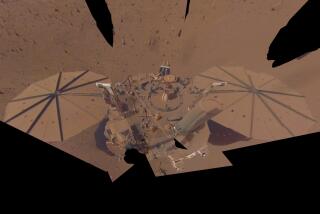Like Finding ‘Snowballs in Hell’ : Mercury: Radar has enabled scientists to confirm the existence of ice in craters on the hottest planet in the solar system. The frozen lakes at the poles may be millions of years old.
- Share via
Astronomers taking a closer look at Mercury, the nearest planet to the sun, have confirmed the existence of frozen water in an arid, airless land where daylight is hot enough to melt lead.
The planet’s lakes of ice, cupped in polar craters miles across and shielded by constant shadows, may be millions of years old, said researchers at the Jet Propulsion Laboratory and the National Astronomy Center at Arecibo, Puerto Rico. The finding is surprising, in part because Mercury is so close to the sun that the temperature at its equator reaches 800 degrees Fahrenheit.
For the record:
12:00 a.m. May 20, 1994 For the Record
Los Angeles Times Friday May 20, 1994 Home Edition Part A Page 3 Column 1 Metro Desk 2 inches; 41 words Type of Material: Correction
Mercury’s ice--A headline on a story in Thursday’s Times about the discovery of ice on Mercury incorrectly stated that Mercury is the hottest planet in the solar system. Venus, because of its runaway greenhouse effect, is the hottest, with a constant temperature of 887 degrees Farenheit.
It is, said one UCLA planetary scientist, like finding “snowballs in hell.”
“I don’t think there is any question that it is real,” said David A. Paige, a professor of planetary science at UCLA. “It is very impressive.”
The research, based on new high-resolution radar maps of Mercury, is published in today’s issue of the science journal Nature.
The study offers convincing evidence that one of the rarest commodities in the inner solar system--the water that gives the orb of Earth its distinctive blue hue when viewed from space--may be more abundant than has been thought.
It also gives additional impetus to the theory that the Earth’s moon may also harbor secret reserves of water in its polar regions and may have an important impact on any future human exploration of the moon, scientists said.
“We don’t know if there is water on the moon, but now there is a better reason to look,” said Bruce Murray, an expert on planetary science and geology at Caltech. Murray was among the first to raise the possibility, more than 30 years ago, that water might be found on the moon.
“If you find it on Mercury, you certainly expect to find it on the moon,” Murray said. “If there are ice deposits on the moon hidden in these craters, that would to me at least change the game a great deal about where you put a lunar base.”
The suggestion that Mercury could have water was first raised about two years ago when radar images of the planet revealed distinctive bright, reflective patches near its poles. The radar echoes reflected by these patches were characteristic of water, the researchers said, but they were initially unsure why any water reserves had not boiled away long ago under the hellish conditions on Mercury’s surface.
Paige theorized that at the poles, where the sun’s light would cast permanent shadows across the floors of large craters, it could be cold enough--well below 32 degrees Fahrenheit--to preserve frozen water for billions of years. Scientists have not ruled out the possibility that the ice is protected by a thin layer of soil, which would be transparent to the radar signals broadcast from Earth.
“When they first discovered that the poles of Mercury had these anomalous bright spots, it wasn’t clear what they were,” Paige said.
Impact craters immediately came to mind. “These are places there where the sun never shone. The sun never peeks down into the crater,” Paige said.
The recent radar studies were detailed enough to line up the reflective patches with known craters on Mercury, apparently confirming the idea. Older and more eroded craters did not contain the deposits.






